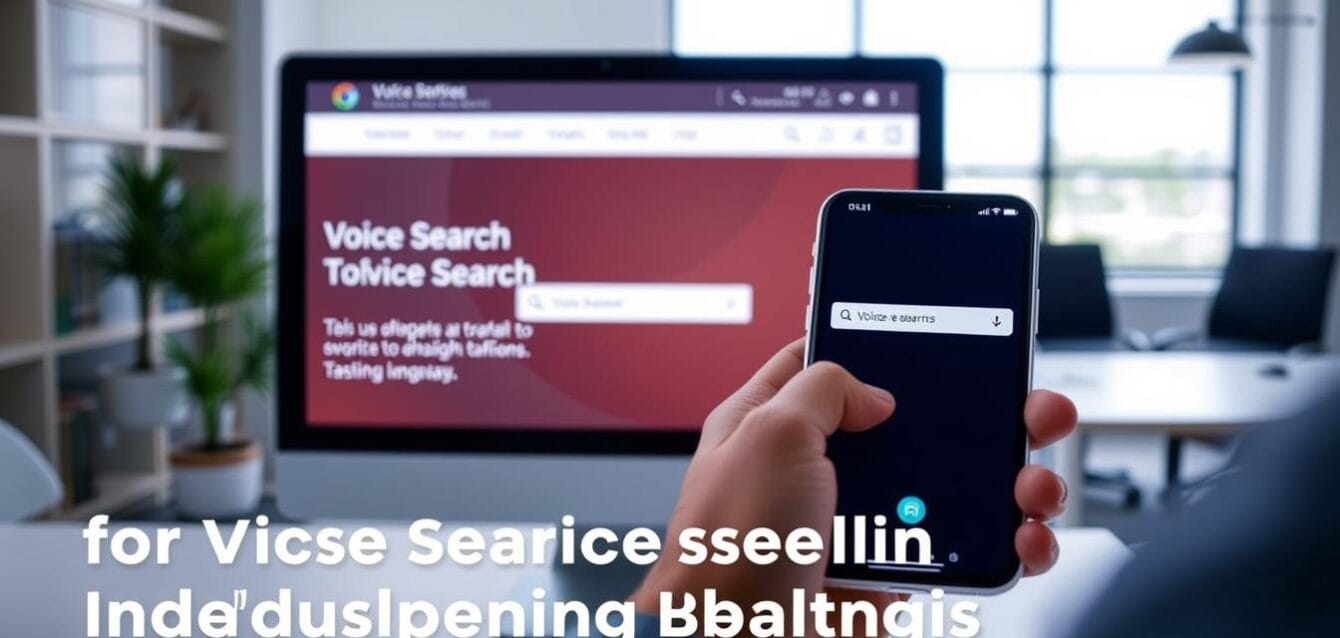700+ million smartphone users and assistants that deliver 81% answer accuracy have changed how people interact with the web.
We know this is a strategic inflection point. In real terms, answers now average 29 words and load 52% faster. That compression of time-to-answer raises expectations for premium brands.
At Macro Webber, we frame this as measurable growth: faster answers, richer intent capture, and higher-quality bookings. Brands like Flipkart, Apollo Hospitals, Swiggy, and Ola report clear lifts in engagement and conversions after optimizing for conversational queries.
We combine data, multilingual content, and enterprise-grade schema to turn curiosity into qualified actions. Our approach aligns digital marketing and seo with local languages and structured snippets to dominate featured answers.
Key Takeaways
- Act now: The shift to conversational interfaces is rapid and measurable.
- Optimizing your website earns faster answers and more qualified leads.
- Multilingual content and structured data drive featured answers and local discovery.
- Proven lifts—engagement and bookings—show direct ROI for premium businesses.
- We partner to operationalize scalable workflows and governance across portfolios.
Why Voice Search in India Is Surging Right Now
Adoption is accelerating as affordable devices and cheaper connectivity change how people get answers. We see mass uptake driven by low-cost smartphones, smart speakers, and falling data prices.
Present-day adoption is practical: inexpensive phones put assistants in more hands. Smart speakers like Amazon Echo and Google Nest extend hands-free use at home. Google’s speech recognition now supports 100+ languages, improving accuracy for multilingual audiences.

Behavioral shift
People default to speaking because it’s faster than typing, especially when driving or multitasking. Roughly half of owners use smart speakers weekly for local info; many use assistants daily on mobile.
- Devices matter: smartphones and smart speakers shape context and speed for answers.
- Enterprise risk: brands without voice-ready information lose high-intent queries to competitors.
- Outcome focus: more local actions, direct calls, and higher conversions for optimized listings.
“Early movers capture sticky user habits — and that translates to measurable share-of-voice in premium categories.”
We prioritize governance and consistent data across listings so assistants return trusted, up-to-date information. The result: faster time-to-value and durable marketing advantage.
Voice Search India: The Market Signals High-Ticket Brands Can’t Ignore
High-ticket brands must treat hands-free queries as a primary acquisition channel. We translate data into clear commercial actions that protect market share and accelerate bookings.
Key stats that quantify demand, speed, and satisfaction with voice assistants
Faster answers, higher accuracy. Voice answers load 52% faster and average 29 words. Google Home delivers ~81% answer accuracy, and 93% of users report satisfaction with assistants.
How “near me” and on-the-go searches are reshaping discovery for local businesses
58% of consumers use assistants to find local businesses; 51% do so for restaurants. Nearly 30% call a business after a local query. That conversion cadence turns discovery into direct pipeline activity.
The competitive edge of ranking in featured snippets and top-three results
40.7% of voice answers come from featured snippets. Owning snippets and top-three placements is not vanity — it is a revenue channel that drives orders, visits, and bookings.

- Opportunity: Structured data and clean entities dramatically improve selection odds.
- Outcome: Top-three dominance yields disproportionate voice exposure and ROI.
How Users Actually Search by Voice in Indian Languages
People usually speak in full questions, not fragments, and that changes how assistants choose answers.
Intent differs: Nearly 10% of spoken queries start with who/what/when/where/why/how versus 3.7% in typed queries. That means answers must be direct, factual, and short.
Conversational vs. typed behavior
Users form longer, conversational phrases. They use more modifiers and fewer isolated keywords. We recommend Q&A blocks, how-tos, and concise definitions that fit the 29-word answer sweet spot.
Multilingual patterns and accuracy gains
Google Assistant supports 100+ languages. Hindi, Tamil, Telugu, and Bengali queries gain from mapped intents and accent-aware testing. Local phrasing and entity-rich language improve pickups.
| Format | Why it wins | Action for teams |
|---|---|---|
| FAQ / Q&A | Matches question-led queries; concise verbatim answers | Write 25–35 word answers; use FAQ schema |
| HowTo | Steps map to task intent and extractable snippets | Structure numbered steps; add HowTo schema |
| Definition / summary | Ideal for single-sentence responses assistants lift verbatim | Lead with a bold first sentence and cite sources |
Measurement matters. Track question-led queries, assistant pickups, and answer coverage to iterate content and prove marketing ROI.
Industry Impact: E-commerce, Healthcare, and Local Services Leading the Charge
We see clear, sector-specific lifts when assistants become a built-in channel for discovery and conversion. The evidence is pragmatic: product queries shorten funnels, clinical FAQs speed bookings, and “best near me” intents drive immediate calls.
E-commerce: product discovery and conversion lift
Flipkart’s Hindi/English assistant delivered 3x engagement. Swiggy’s voice-enabled flows raised order completion by 20% and Ola’s bookings rose 35%.
Action: add conversational product snippets, inventory markup, and checkout flows that reduce friction for customers.
Healthcare: faster answers and appointment growth
Apollo Hospitals used structured FAQs and clinic-level pages to drive a 32% lift in appointments. Precise, trustworthy content shortens the path from question to book now.
Restaurants and hospitality: “best” and “near me” driving walks and calls
A Delhi restaurant saw a 27% foot-traffic lift after targeted optimization. Nearly 30% of local searches result in an immediate call.
- Enterprise prerequisites: clean NAP, multilingual pages, and consistent attributes across locations and devices.
- Content trust: symptom explainers, service pages, and menu highlights must be precise so assistants surface confident answers.
- Schema wins: category schemas and inventory markup help websites appear in high-value answer contexts.
“Treat assistants as a primary conversion surface and design workflows that close in one interaction.”
The Optimization Playbook for Indian Languages
We deliver a stepwise playbook so teams can turn local intent into measurable revenue. This is practical work: governance, speed, and snippet-ready content executed at scale.
Local SEO essentials
We mandate Local SEO hygiene. Complete the google business profile, verify NAP, set precise categories, hours, and attributes.
Proactive reviews matter. A review strategy and review responses improve selection by assistants and increase calls and visits.
Content for assistant-friendly results
We operationalize content with an FAQ library mapped to priority queries. Each answer targets ~29 words and is citation-backed for E-E-A-T.
- Q&A blocks for snippet eligibility.
- Concise, conversational lines that load verbatim in voice search results.
Technical wins and schema
We harden the stack with FAQPage, HowTo, Product, LocalBusiness, and MedicalOrganization markup. Validate schema at scale to improve parsability.
Engineer speed: target sub-2.5s mobile LCP and lean code paths so the website outperforms average pages.
Multilingual workflows
We deploy centrally governed glossaries and regional templates. QA covers dialect and accent nuances to keep content consistent across languages.
“Measure answer-box wins, local pack coverage, calls, and assistant-driven revenue.”
We measure relentlessly—track featured snippet lifts, booking conversions, and the data that proves ROI for digital marketing. These strategies convert assistants into a predictable channel for high-ticket brands using voice search.
Proven Moves: What Leading Brands Did Differently
Top enterprises retooled local content and listings to make answers immediate and actionable.
Consumer brands
Haldiram’s captured near-me demand by publishing regional pages and google business FAQs in local languages. The result: stronger placement for store queries and measurable uplift in foot traffic.
Healthcare networks
Dr. Batra’s built clinic-level pages with hours, services, and long-tail Q&A. This matched how patients ask questions and delivered higher appointment rates.
On-demand platforms
Swiggy and Ola embedded voice assistant flows to shorten the path from intent to action. Swiggy saw +20% order completions; Ola reported +35% bookings.
Principles that transfer:
- Standardize location pages and store info across the web.
- Use FAQ blocks and timing details to answer natural queries.
- Enforce content QA and a central taxonomy for services.
- Surface structured reviews and UGC signals so assistants can validate prominence for local businesses.
| Challenge | Move | Outcome |
|---|---|---|
| Fragmented listings | Centralize google business and directory data | Consistent citations; higher selection rate |
| Weak local content | Create regional pages with Q&A and timings | Improved relevance; more calls and bookings |
| Friction to purchase | Embed assistant-ready actions and confirm flows | Higher completions and lower drop-off |
“These are systems moves, not one-off fixes — that is how enterprises scale measurable results.”
Risk, Reality, and ROI: What Could Go Wrong—and How to De-risk
Every enterprise must weigh the real operational risks before scaling assistant-driven channels. We map risks to clear controls so leaders can act with confidence and protect brand value.
Accuracy, privacy, and bias: safeguarding consumers while improving results
Accuracy gaps matter: assistants answer ~81% correctly, yet 48% of users worry about devices that are “always listening.” We treat both stats as operational mandates.
Mitigations: enforce fact-checking, medical and legal review, and version control so outdated information never surfaces. Publish plain-language privacy policies and limit PII collection. Architect consent-based analytics for assistant interactions.
We run dialect tests to catch bias early and monitor outputs daily to correct misinterpretations before they reach consumers.
Scaling content: processes, governance, and measurement for enterprise SEO
Scaling without rules creates confusion across websites and listings. We define roles, SLAs, and escalation paths so updates deploy fast and safe.
- Automated schema validation, link checks, and content linting for QA.
- Prioritize high-intent categories to align marketing spend with measurable revenue.
- Test across smart speakers, mobile assistants, and in-app experiences to ensure parity.
“De-risking is a governance exercise: traceable content, consented analytics, and ROI-linked priorities.”
Conclusion
Brands that deliver concise, multilingual answers at scale will convert intent into revenue faster than rivals. The math is simple: featured snippets supply 40.7% of assistant answers and nearly 30% of local voice searches turn into immediate calls. Early adopters report clear lifts—+20% order completions, +35% bookings, +32% appointments, +27% foot traffic—proof that execution produces measurable results.
We recommend a focused play: own snippet-ready content, harden schema, and scale Q&A libraries across languages. This aligns seo, digital marketing, and product so your website and web listings become primary conversion surfaces for users on devices and in stores.
Act now. Capacity for enterprise onboarding is limited this quarter. Explore Macro Webber’s Growth Blueprint or book a consultation to deploy WebberXSuite™ and the A.C.E.S. Framework. Secure category leadership and turn conversational queries into predictable revenue.



